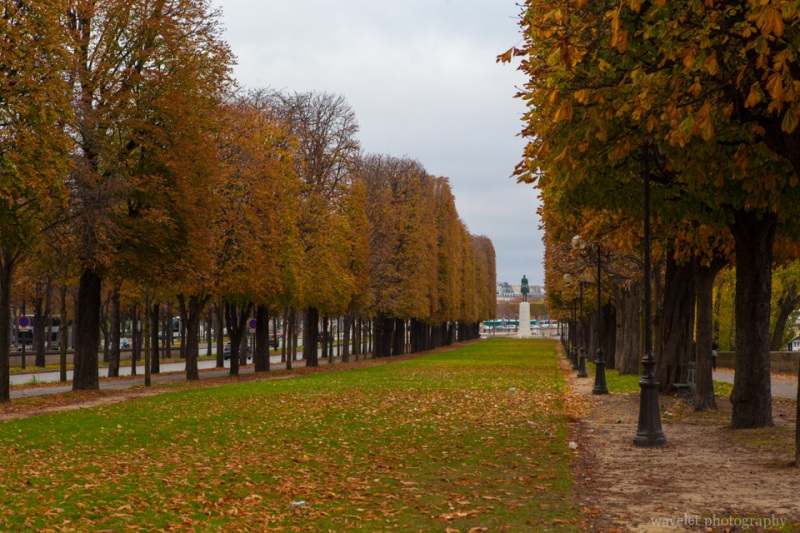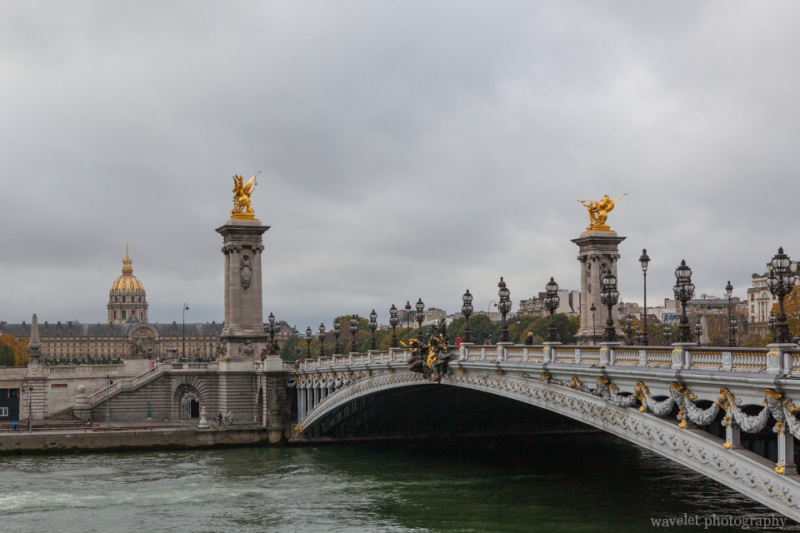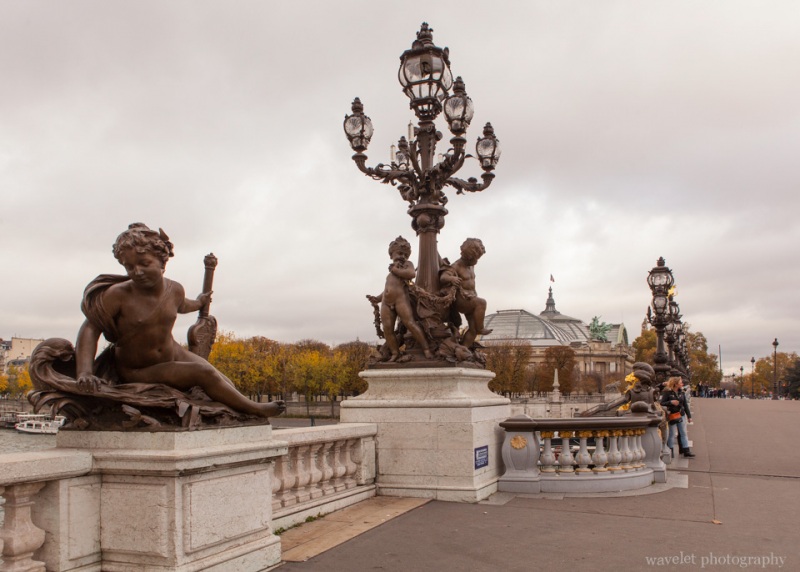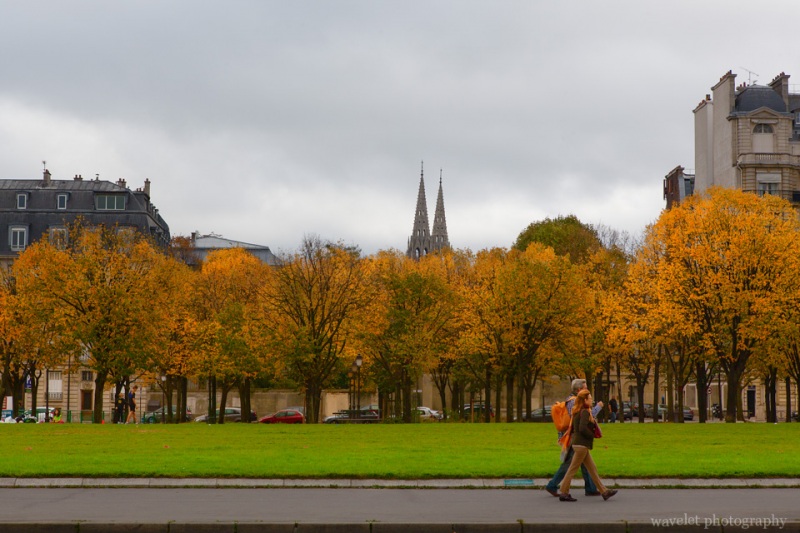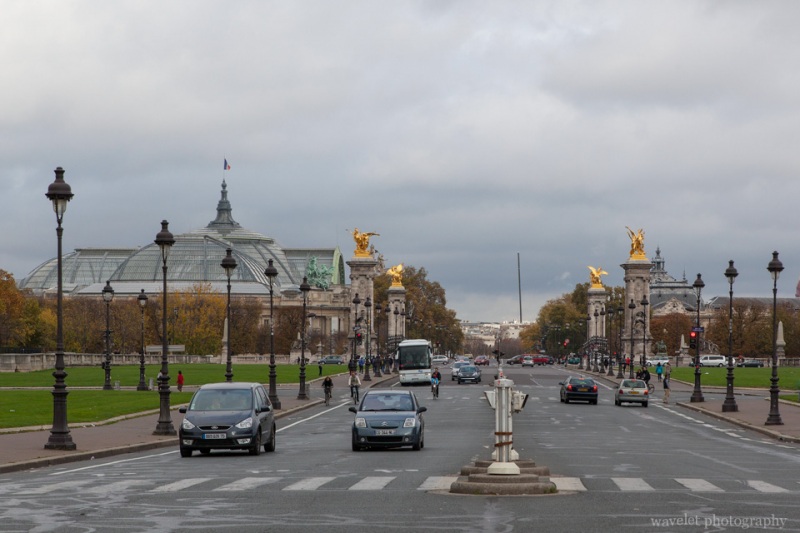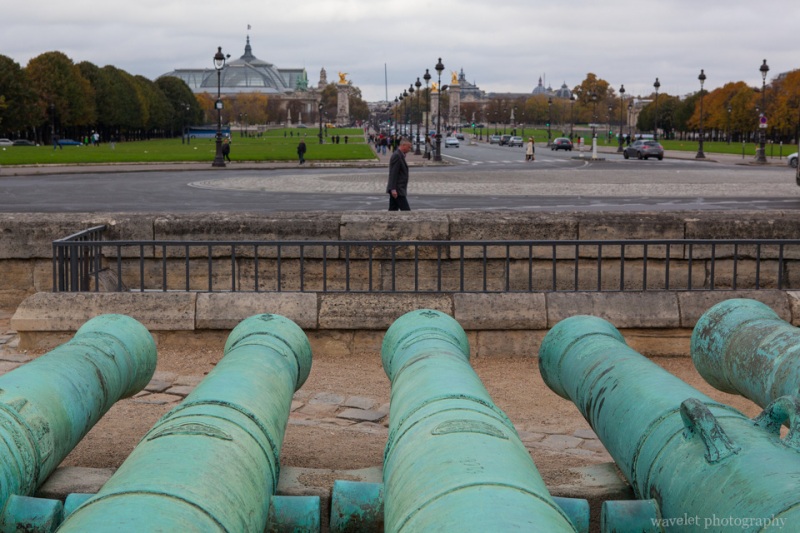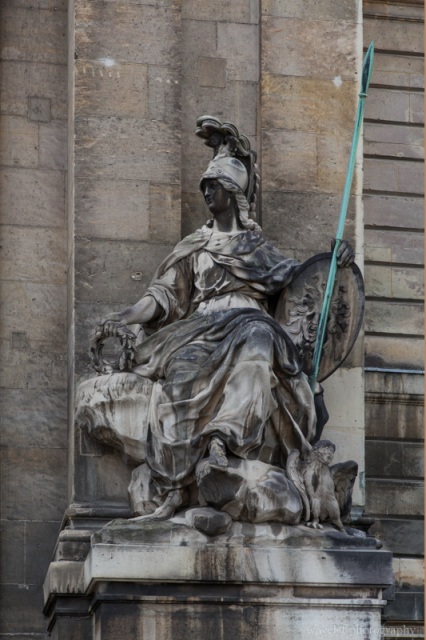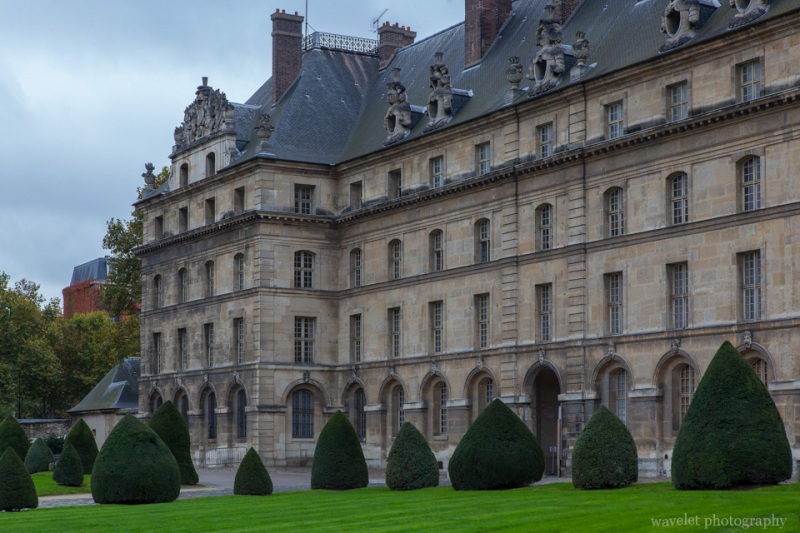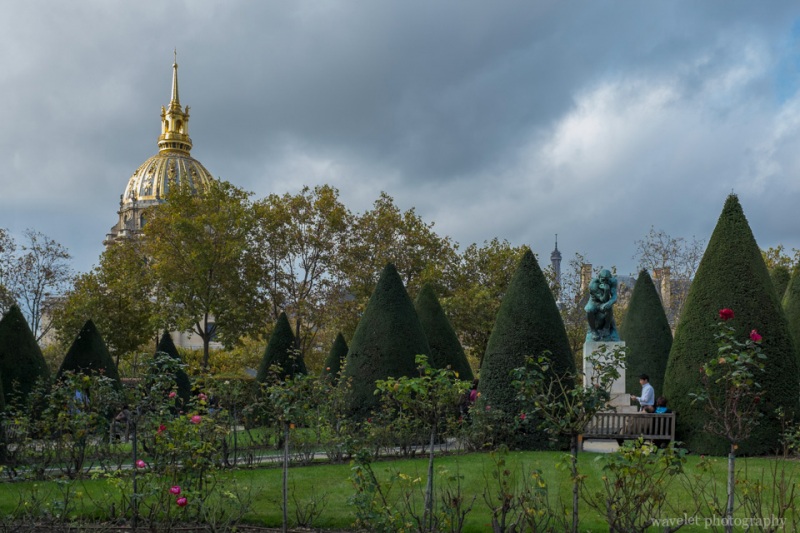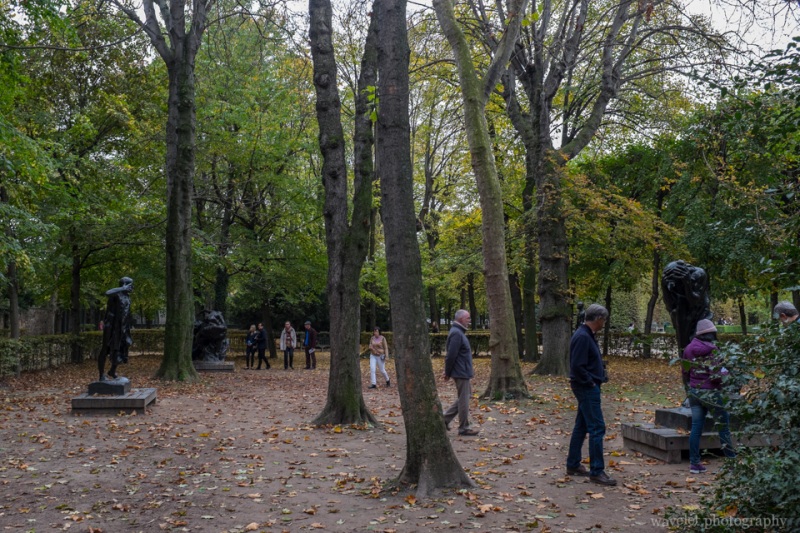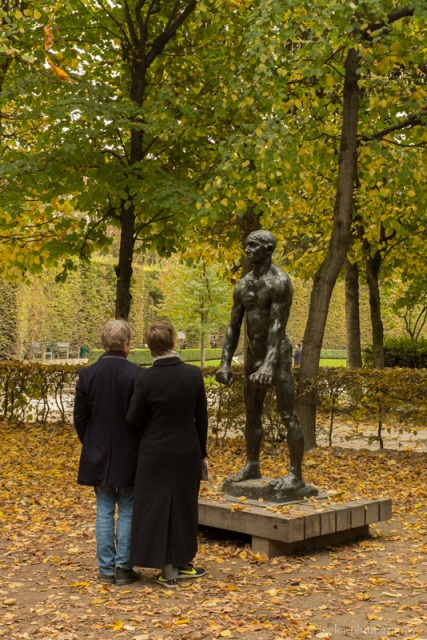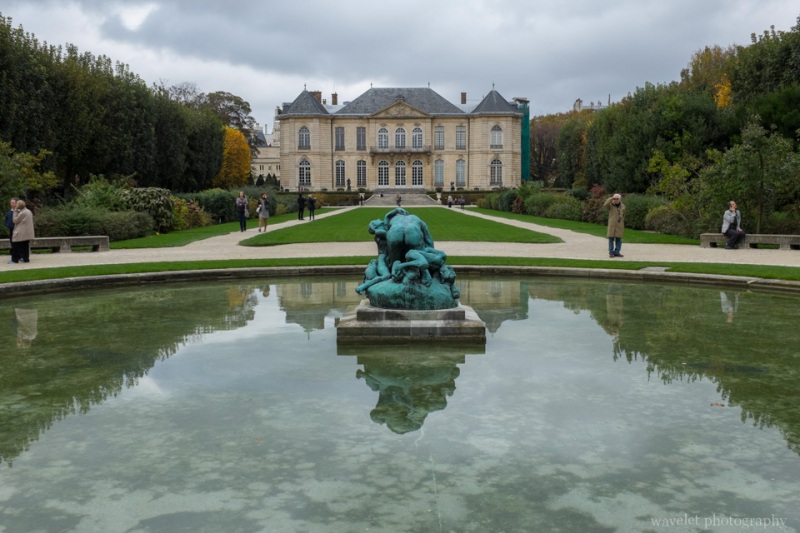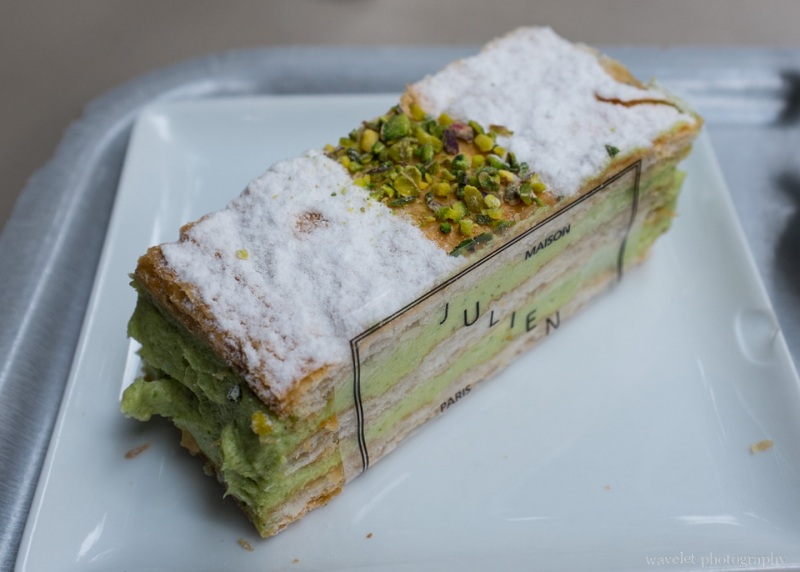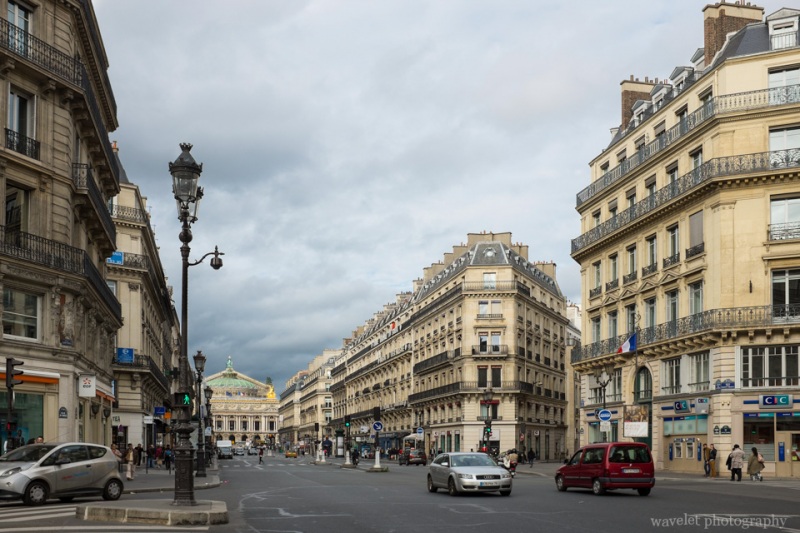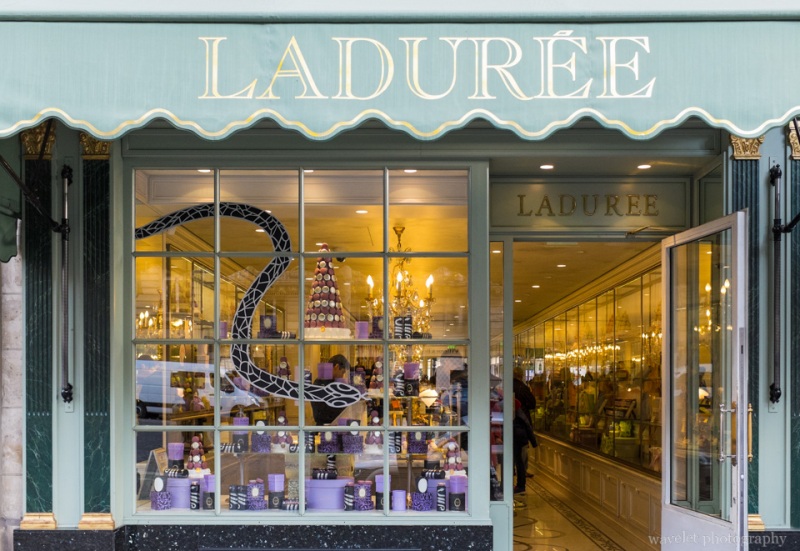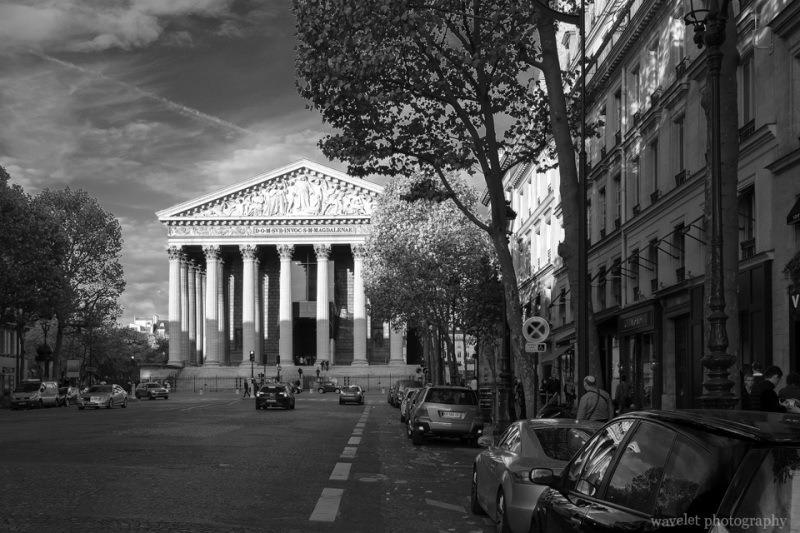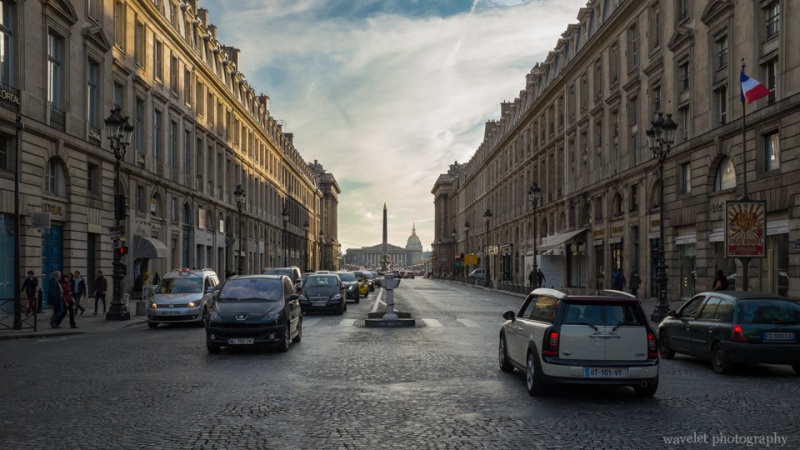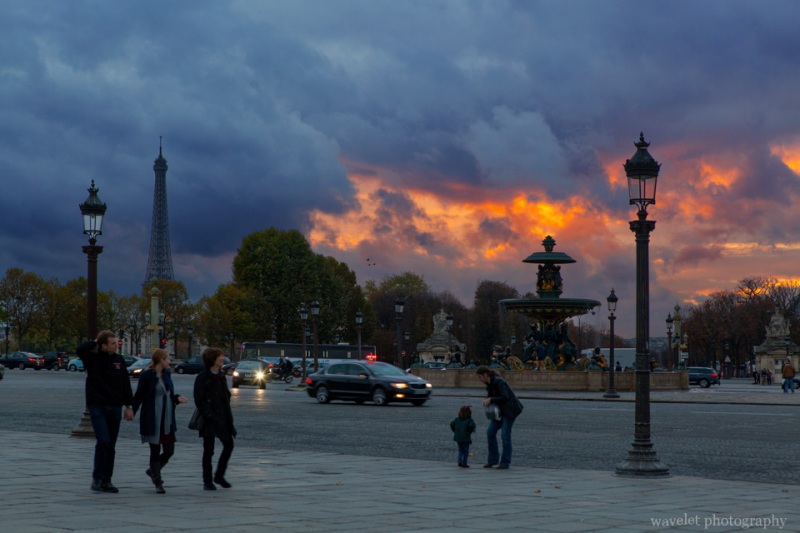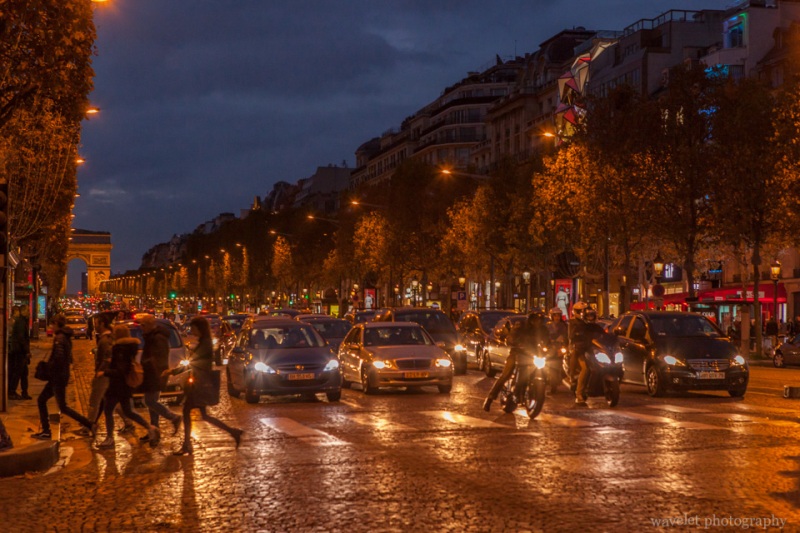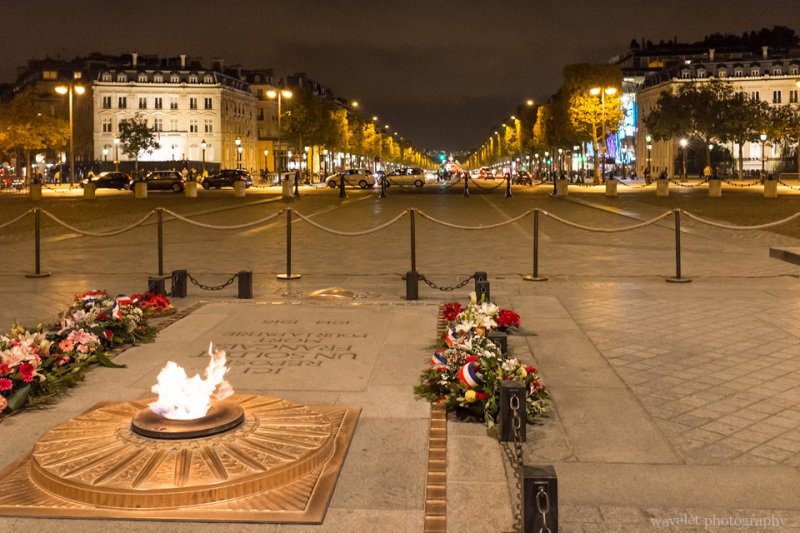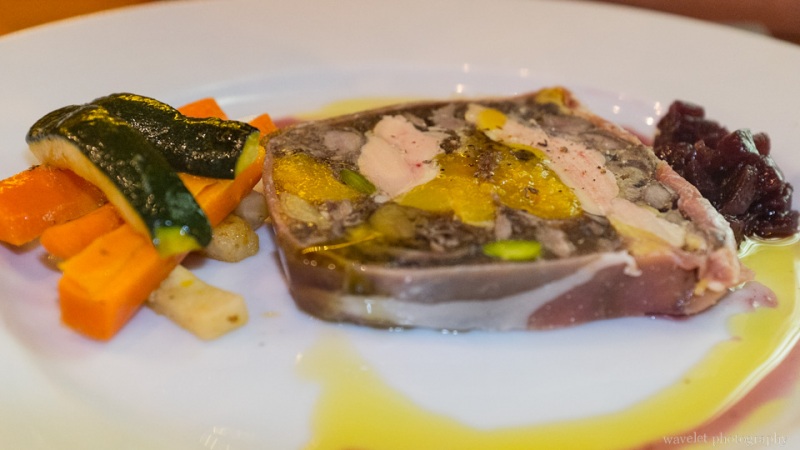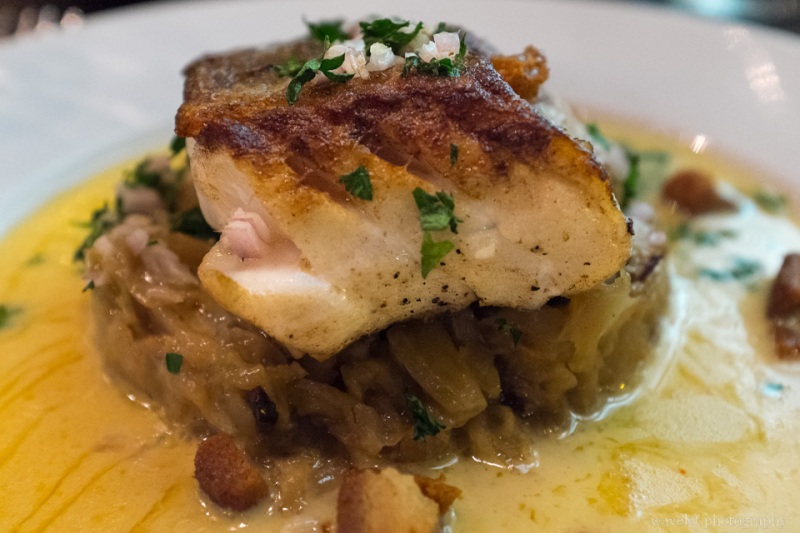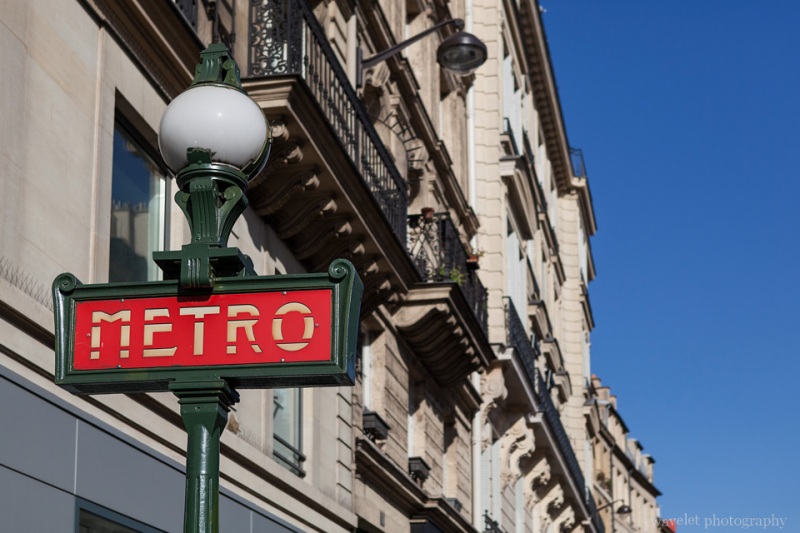2014.10.31今天特意早起,准备去看巴黎圣母院。在楼下的餐厅吃过早饭,我们八点钟就出了门。路过圣米歇尔广场(Place Saint-Michel)的时候,还是冷冷清清。白天这里可是人来人往,车流如织,是法国人喜欢碰头的地方。在照片的右侧就是圣米歇尔喷泉,它有160年历史,名气很大。不过我觉得它颇为破落,颜色暗淡,加上白天人多,很不上像。

Place Saint-Michel, Latin Quarter, Paris
不一会儿,就走到了巴黎圣母院。巴黎圣母院位于西岱岛(Île de la Cité)的东端,始建于1163年,从唱诗堂开始,到中殿、西侧面,双塔完成时已是九十年之后。其后,教堂的南北方向的耳堂又经过改建,后殿加建了飞扶壁(buttresses ),直到1345年才完工,前后花了180年。教堂早晨八点开门,游客还不是很多。巴黎圣母院的西立面庄严肃穆、比例精美、雕梁画柱,是法式哥特风格教堂的经典之作;内部装饰却非常俭朴。

The nave looking toward the chancel, Notre-Dame, Paris

Chancel windows of Notre-Dame, Paris

A chapel of Notre-Dame, Paris
问了教堂的工作人员才知道教堂的塔楼要到十点钟才开门。时间还早,我们决定先去参观先贤祠(Panthéon)。从巴黎圣母院到先贤祠直线距离不过一公里,只要沿着圣雅克路(Rue Saint-Jacques)走就好。途中路过索邦大学的侧门,本想照张相,却发现门口排满垃圾桶和修路的路障,只好放弃。

A small stree on Rue Saint-Jacques, Latin Quarter, Paris
先贤祠位于一个椭圆形广场的中央。我们先沿着左侧走到后面一个三角形的小广场,圣日内维耶广场。广场上的圣艾蒂安-迪蒙教堂(Saint-Étienne-du-Mont)面积不大,先后有几座教堂在同样的位置重建。现在的教堂完成于17世纪初,既有哥特式花窗、又融合了文艺复兴风格的钟楼,建筑特点十分独特。教堂供奉着圣日内维耶的圣骨箱,传说中她在六世纪的时候,保护了巴黎不受匈奴人的侵犯。同样葬在教堂里的还有物理学家帕斯卡(Blaise Pascal )和剧作家拉辛(Jean Racine)。教堂里螺旋形的圣坛围屏(rood screen)花纹精美,非常引人注目。可惜我们来的太早,教堂还没有开门,不能得以一观。

Saint-Étienne-du-Mont, Latin Quarter, Paris
看过《Midnight in Paris》的人应该可以认出这个场景。片中的主人公迷路后,就是坐在圣艾蒂安-迪蒙教堂侧面的台阶上,被一辆老式轿车接走,开始了一段奇妙的穿越之旅。

The side door of Saint-Étienne-du-Mont, Latin Quarter, Paris

The street next to Saint-Étienne-du-Mont, Latin Quarter, Paris

Place Emmanuel Levinas near Panthéon, Latin Quarter, Paris
我们沿着亨利四世中学(Lycée Henri-IV)后面的小路走了一圈,又回到先贤祠所在的广场。先贤祠建于十八世纪中,本来的计划是用以供奉圣日内维耶的教堂,建成时正赶上法国大革命,于是被改为纪念堂,用来安葬为法兰西做出杰出贡献的伟人:伏尔泰、卢梭、雨果、拉格朗日、以及居里夫人均葬于此。这是一座新古典主义风格的建筑,门廊的石柱和山墙与罗马的万神殿(都叫做Panthéon)十分相似。圆顶高七十米。1851年,傅科在这里做了著名的傅科摆的试验来证明地球的自转。

Panthéon, Latin Quarter, Paris

Look through Rue Soufflot from Panthéon, Latin Quarter, Paris
我们沿着圣雅克路往回走,路上开始热闹起来。我们坐下喝了些咖啡,又买了一些小纪念品。

Collège de France, Latin Quarter, Paris

Eglise St-Severin, Latin Quarter, Paris
回到巴黎圣母院的时候已是将近11点。等待登上塔楼的游客在教堂右侧排成一条长龙。我们在左岸还要再住两晚,还有时间。

Notre-Dame in autumn, the eastern side of the cathedral, Paris

Pope John Paul II statue and the South Rose Window, Notre-Dame, Paris
老婆先在旅馆休息,我打算去第六区探探路。穿过旅馆后面纵横的小路,很快我就走到圣日耳曼大道(Boulevard Saint-Germain)。大街的这一段与塞纳河平行,是贯穿巴黎左岸的主干道,明显商业气息要比拉丁区更浓。随便一走,就看见一家星巴克,我还以为对咖啡文化自视甚高的巴黎不会有星巴克的市场,后来发现居然还有不少分店。

Boulevard Saint-Germain, Paris

Boulevard Saint-Germain, Paris
继续走到卢森堡花园,第一眼看到的美第奇喷泉在正午树影的掩映下让我十分惊艳。如此美景实在不忍独享,我赶快走回旅馆,叫上老婆一起上路。我们先在旅馆旁的Khao Thai吃了午饭。这是一家泰式餐馆,和左岸大多数餐馆一样,桌子紧挨着桌子,不容人侧身而过。他家的酸豆鸭肉做的很好吃。对了,在巴黎吃饭如果要白水,莫忘了说要“tap water”。只说“water”的话,肯定拿上来的是瓶装水,要收钱的。

Canard au tamarins, Khao Thai on Rue Dauphine, Paris
圣日耳曼大道两侧的小巷中,小店的数量只能用无穷无尽来形容,尤其以圣日耳曼大道和卢森堡公园之间的食品商场(Marché St-Germain)周围为最甚。其中最让人感到琳琅满目的当属甜品店。高档甜品店的店面宽敞明亮,装饰得如同首饰店一般。像Un Dimanche à Paris,Pierre Hermé这样的名店门口总是排着队。进了几个甜品店才知道,马卡龙 (Macaron)原来不是Ladurée的专利,每个店都卖。

Pastry store near Marché Saint-Germain, Paris

A butcher store near Marché Saint-Germain, Paris
卢森堡公园始建于1615年,是法国国王亨利四世的王后,玛丽亚·美第奇,在丈夫死后修建的。“美第奇”在文艺复兴时期的欧洲可是赫赫有名的大家族。起家于佛罗伦萨的银行业,美第奇家族逐步渗透到整个欧洲的皇室、宗教和政治势力中。他们不但拥有财富和权力,还特别喜欢资助和收藏艺术品,被称为是文艺复兴的教父。我们在佛罗伦萨的时候就看到过一幅标语,大概的意思是,“很遗憾很多当代收藏家的品味还不如美第奇家族”。这位玛丽亚皇后的一生也可谓跌宕起伏,从宫斗、到摄政、到被自己的儿子流放,亨利四世的被暗杀和她也不无瓜葛。
从卢森堡公园东北面走进公园,第一个看到的就是美第奇喷泉。临路的是一个狭长的池塘,池塘的尽头是喷泉的雕塑。整个建筑被绿树包围,池塘中鱼儿游泳、鸭子戏水,十分的幽静。美第奇喷泉在十九世纪中经过大规模重建,现在看到的雕像都是那时候重新替换的。斑驳的树影虽然看起来很美,但是阳光过强,对摄影反而是个困难。

La fontaine Médicis in Jardin du Luxembourg, Paris
虽然也是绿树如茵、鲜花满地,但是卢森堡公园在设计上走的不是曲径通幽的路子,而是视野开阔,树木成行,颇有正大光明的感觉,据说是仿照佛罗伦萨的碧提宮所建。卢森堡宫现在是法国参议院所在地。卢森堡宫前的圆形大池塘周边摆放着很多的绿色铁椅,几乎全部被人坐满,看起来以当地人居多。很多家长带着小孩儿在池塘里放游模型帆船。这不过是星期五的下午,巴黎人难道这么的清闲。后来才知道法国是一周35小时工作,也许周末在星期五的下午就开始了吧。

Luxembourg Palace, Jardin du Luxembourg, Paris
公园的西侧是一片树林和孩子们的娱乐场,比如小马拉车、溜旱冰等等。其间还点缀着近百座雕塑。

Statue in Jardin du Luxembourg, Paris

Statue in Jardin du Luxembourg, Paris
卢森堡公园的西北门是卢森堡博物馆,旁边有一家巴黎有名的茶点店,Angelina。位于杜乐丽花园旁边的一家应该是本店。这一家面积很小。Angelina的热巧克力和看起来像面条一样的Mont Blanc最有名。怕太甜,我们只点了一份Mont Blanc和一杯咖啡。

Le Mont-Blanc, Angelina, near Musée du Luxembourg, Paris
沿着波拿巴街(Rue Bonaparte)往回走,不一会儿就走到圣叙尔比斯教堂(Église Saint-Sulpice)。教堂于17世纪中起建,前后花了130年。最后因为资金问题没有完工,到现在南北钟楼还是不对称的。教堂的面积很大,是巴黎仅次于巴黎圣母院的第二大教堂,但是从西立面来看,要比巴黎圣母院朴素的多。小说《达芬奇密码》中的很多重要情节就在这里展开。

Église Saint-Sulpice, Paris

Fontaine Saint-Sulpice, Paris
再向北走,又回到左岸最繁华的地区,圣日耳曼德佩区(Saint-Germain-des-Prés)。这里最有名的当属临街的两家咖啡店,双偶咖啡(Les Deux Magots)和花神咖啡(Café de Flore)。这两家咖啡店可算是二十世纪初文学艺术史上的传奇,随便说说都是,这是毕加索坐过的椅子,这是萨特用餐的桌子。不过那是一百年前的事情,现在更像是游客体验生活的名胜罢了。与花神咖啡店一街之隔的圣日耳曼德佩修道院(Église Saint Germain des Prés)是巴黎最早的教堂之一,也是这一地区名称的由来,笛卡儿也安葬在这里。

Les Deux Magots, Saint-Germain-des-Prés, Paris

Saint-Germain-des-Prés at dusk, Paris
回到旅馆,离晚餐还有一会儿。我当然抓紧这段时间出去看看夜景。巴黎中心的景点离得都不太远,从旅馆走到卢浮宫实际也就是一刻钟的时间。

Institut de France and Pont des Arts with Notre-Dame at the background, Paris

Palais du Louvre at night, Paris
卢浮宫广场前方有一座“小凯旋门”(Arc de Triomphe du Carrousel)。从这里望去,可以看到协和广场上的方尖碑,和香榭丽舍大道另一端的凯旋门。这可是等了很久才等到没有人在镜头里。一辆自行车从我身边骑过,车上的人向我喊,“What a city!”。Yes, What a city!

Arc de Triomphe du Carrousel, Paris









